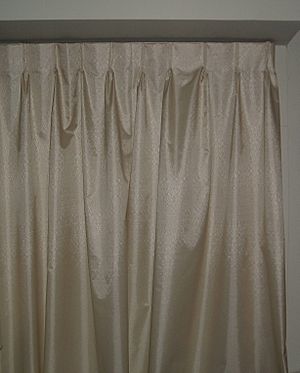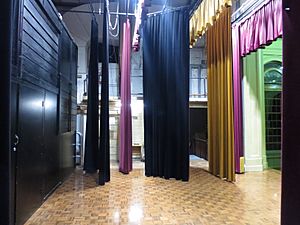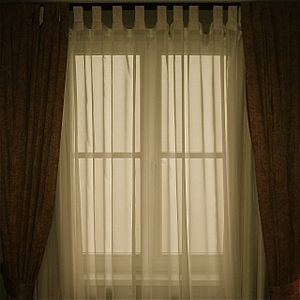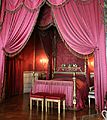Curtain facts for kids
A curtain is a piece of cloth that helps block or dim light. It can also keep out drafts or even water, like a shower curtain. In a theater, a curtain is a large movable screen or drape. It separates the stage from where the audience sits. Curtains can also be used as a backdrop on stage.
Curtains hung over a doorway are called portières. People often hang curtains inside windows to block light, especially at night for sleeping. They also stop light from escaping outside, which helps with privacy. Curtains come in many shapes, materials, sizes, colors, and patterns. You can find them in department stores, and some shops sell only curtains.
Curtains are chosen for how easy they are to clean and how well they resist ultraviolet light. They also differ in how much dust they collect, how much noise they absorb, and if they are fire-resistant. Curtains can be moved by hand, with cords, or even with remote controls. Small ties called curtain tie-backs hold them open. The size of curtains needed depends on the window and the type of curtain.
Curtains are a type of window treatment. They help make a room look complete. Window treatments control how much natural light comes into a room. Curtains look best in daylight, but with good indoor lighting, they can also look attractive at night.
Contents
History of Curtains
Did you know curtains have been around for a very long time? People used them even in ancient times! In old cities like Olynthus, Pompeii, and Herculaneum, archaeologists found proof that curtains were used as room dividers. Old pictures from the 2nd to 6th centuries show curtains hanging from rods across archways. This means curtains have been part of homes for thousands of years.
How Curtains Control Light and Heat
Curtains are made from different kinds of fabrics. Some fabrics are thick, and others are thin. Each type is good at blocking light and keeping heat in or out. For the best temperature control, curtains should fit close to the window. This helps stop cold or warm air from sneaking around them. While some special designs can help with this, most curtains are used just for decoration. They make rooms feel warm and cozy.
Sheer Curtains: Light and Privacy
A sheer curtain is made from a see-through fabric. Think of a loosely woven polyester or a cotton lace. Sheer curtains let most of the light come through. The fabric weave offers some protection from the sun's UV rays. They also let you see outside clearly.
Sheer curtains are sometimes called "privacy curtains." During the day, you can usually see out, but people outside can't see directly into your home. Because they are loosely woven, sheer curtains don't offer much heat insulation. They are great for letting light in while still giving you a little privacy.
Uncoated Curtains: More Light Blockage
Uncoated fabrics offer more heat insulation and block more light. Most curtains are made from these fabrics. They are usually a tightly woven fabric, often a mix of cotton and polyester. These fabrics are mostly opaque, meaning you can't see through them easily in normal light.
Uncoated fabrics provide good heat insulation because they are tightly woven. However, they are usually not thick enough to completely block very strong sunlight. So, if you close these curtains to block direct sun, you might still see some light shining through. They are a good choice for balancing light and heat control.
Images for kids
-
Bathtub with curtain at the Bernheimer House
See also
 In Spanish: Cortina para niños
In Spanish: Cortina para niños


















